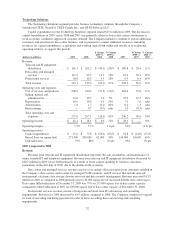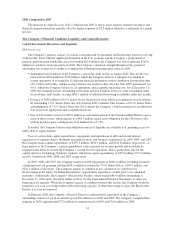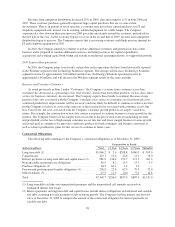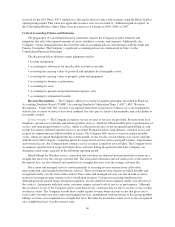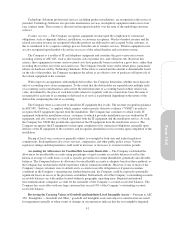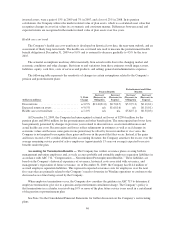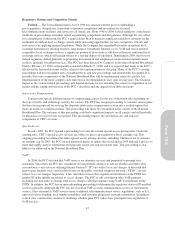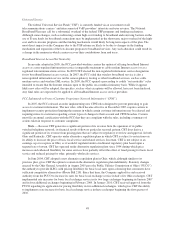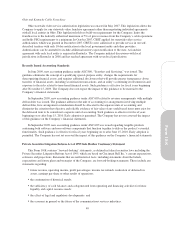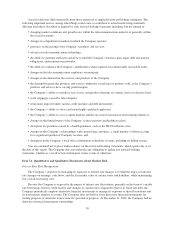Cincinnati Bell 2009 Annual Report Download - page 110
Download and view the complete annual report
Please find page 110 of the 2009 Cincinnati Bell annual report below. You can navigate through the pages in the report by either clicking on the pages listed below, or by using the keyword search tool below to find specific information within the annual report.received for the 16% Notes, $47.5 million was allocated to the fair value of the warrants using the Black-Scholes
option-pricing model. This value less applicable issuance costs was recorded to “Additional paid-in capital” in
the Consolidated Balance Sheet. There were no exercises of warrants in 2009, 2008, or 2007.
Critical Accounting Policies and Estimates
The preparation of consolidated financial statements requires the Company to make estimates and
judgments that affect the reported amounts of assets, liabilities, revenue, and expenses. Additionally, the
Company’s senior management has discussed the critical accounting policies and estimates with the Audit and
Finance Committee. The Company’s significant accounting policies are summarized in Note 1 to the
Consolidated Financial Statements.
The discussion below addresses major judgments used in:
•revenue recognition;
•accounting for allowances for uncollectible accounts receivable;
•reviewing the carrying values of goodwill and indefinite-lived intangible assets;
•reviewing the carrying values of property, plant and equipment;
•accounting for business combinations;
•accounting for taxes;
•accounting for pension and postretirement expenses; and
•accounting for termination benefits.
Revenue Recognition — The Company adheres to revenue recognition principles described in Financial
Accounting Standards Board (“FASB”) Accounting Standards Codification Topic (“ASC”) 605, “Revenue
Recognition.” Under ASC 605, revenue is recognized when there is persuasive evidence of a sale arrangement,
delivery has occurred or services have been rendered, the sales price is fixed or determinable, and collectibility is
reasonably assured.
Service revenue — The Company recognizes service revenue as services are provided. Revenue from local
telephone, special access and data and internet product services, which are billed monthly prior to performance of
service, and from prepaid wireless service, which is collected in advance, is not recognized upon billing or cash
receipt but rather is deferred until the service is provided. Postpaid wireless, long distance, switched access and
reciprocal compensation are billed monthly in arrears. The Company bills service revenue in regular monthly
cycles, which are spread throughout the days of the month. As the last day of each billing cycle rarely coincides
with the end of the Company’s reporting period for usage-based services such as postpaid wireless, long distance,
and switched access, the Company must estimate service revenues earned but not yet billed. The Company bases
its estimates upon historical usage and adjusts these estimates during the period in which the Company can
determine actual usage, typically in the following reporting period.
Initial billings for Wireline service connection and activation are deferred and amortized into revenue on a
straight-line basis over the average customer life. The associated connection and activation costs, to the extent of
the upfront fees, are also deferred and amortized on a straight-line basis over the average customer life.
Data center and managed services consist primarily of recurring revenue streams from collocation,
interconnection, and managed infrastructure services. These recurring revenue streams are billed monthly and
recognized ratably over the term of the contract. Data center and managed services can also include revenues
from non-recurring revenue streams such as installation revenues. Certain non-recurring installation fees,
although generally paid in lump sum upon installation, are also deferred and recognized ratably over the term of
the contract. Agreements with data center customers require certain levels of service or performance. Although
the occurrence is rare, if the Company fails to meet these levels, customers may be able to receive service credits
for their accounts. The Company records these credits against revenue when an event occurs that gives rise to
such credits. In multi-year data center and managed services arrangements with increasing or decreasing monthly
billings, revenues are recognized on a straight-line basis. Revenue for leased data center assets is also recognized
on a straight-line basis over the contract term.
40




